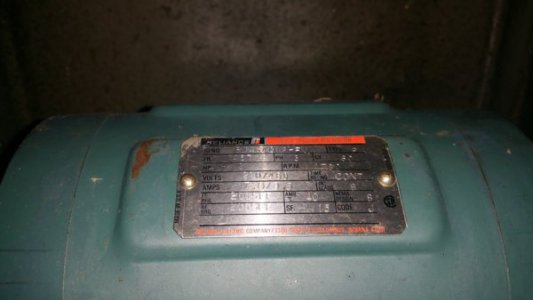- Joined
- Jan 1, 2018
- Messages
- 1,152
I recently purchased a 70's vintage South Bend 13" lathe with a 2hp 3ph motor.

30 years ago I built a 10hp balanced rotary phase converter to power my 7 1/2hp radial arm saw. Since then I have been mostly using VFD's to power my machines (mostly woodworking machines). All of my 3ph machines have been very simple as far as controls... start, stop... with a speed control that I actually use on a wood shaper.
When I purchased my SB lathe I got to see it under power and was very impressed with the instant reverse and could see how this would be useful for operations like threading! I know VFD's do not like having the load suddenly cut from the VFD and I am sure they would like having the load cut, two legs swapped and re-energized much less. My thinking is if I want speed control and instant reversing I am going to have to get more intimate with VFD's.
I THINK I have decided on a Hitachi WJ200-022SF rated for 3 HP, 11 Amp, 2.2 kW, Constant Torque Sensorless Vector AC Drive, Input: 200 - 240VAC 1ph.
https://www.driveswarehouse.com/WJ200-022SF-P21546.aspx
What attracted me to the Hitachi WJ200 is it has some basic programming capability. I believe I can program it to brake the motor from full speed to a stop then spin the motor back up to speed in the opposite direction. I believe with a braking resistor I can make this reversing operation happen pretty quickly. I chose the WJ200-022SF because it is rated at 3hp giving me a bit of head room in muscling the 2hp motor direction quickly.
Does this make sense? Does anyone else quick reverse a lathe? For threading? Is quick reversing even acceptable practice for a lathe?
My other option is to pull out an old 7.5 RPC and just run the SB lathe on that without having to re-engineer the controls. My 10hp RPC is in the woodworking side of my shop and running a line to it from the SB would be a lot more hassle than I want to deal with.
Any thoughts? Any advice from other lathe owners controlled by a VFD?

30 years ago I built a 10hp balanced rotary phase converter to power my 7 1/2hp radial arm saw. Since then I have been mostly using VFD's to power my machines (mostly woodworking machines). All of my 3ph machines have been very simple as far as controls... start, stop... with a speed control that I actually use on a wood shaper.
When I purchased my SB lathe I got to see it under power and was very impressed with the instant reverse and could see how this would be useful for operations like threading! I know VFD's do not like having the load suddenly cut from the VFD and I am sure they would like having the load cut, two legs swapped and re-energized much less. My thinking is if I want speed control and instant reversing I am going to have to get more intimate with VFD's.
I THINK I have decided on a Hitachi WJ200-022SF rated for 3 HP, 11 Amp, 2.2 kW, Constant Torque Sensorless Vector AC Drive, Input: 200 - 240VAC 1ph.
https://www.driveswarehouse.com/WJ200-022SF-P21546.aspx
What attracted me to the Hitachi WJ200 is it has some basic programming capability. I believe I can program it to brake the motor from full speed to a stop then spin the motor back up to speed in the opposite direction. I believe with a braking resistor I can make this reversing operation happen pretty quickly. I chose the WJ200-022SF because it is rated at 3hp giving me a bit of head room in muscling the 2hp motor direction quickly.
Does this make sense? Does anyone else quick reverse a lathe? For threading? Is quick reversing even acceptable practice for a lathe?
My other option is to pull out an old 7.5 RPC and just run the SB lathe on that without having to re-engineer the controls. My 10hp RPC is in the woodworking side of my shop and running a line to it from the SB would be a lot more hassle than I want to deal with.
Any thoughts? Any advice from other lathe owners controlled by a VFD?
Last edited:

